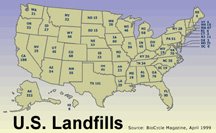LF Disposal May Pose Greater Health Risks Than WTE Treatment, Student Research Shows

Earth Institute News
Disposing of waste in landfills increases health risks 30-fold, when compared to using waste-to-energy treatment, according to a study by a student in the Masters in Public Health program at Columbia University.
Disposing of waste via landfills increases health risks 30-fold, compared with using waste-to-energy treatment — which generates electricity by burning waste — for disposal. This is according to a study conducted by a student in the Masters in Public Health (MPH) program at the Mailman School at Columbia University.
The study, carried out by Pearl Moy as her master’s thesis, a requirement for completing her MPH degree, was the first comparison of the health risks between landfill and waste-to-energy (WTE) treatment of municipal solid wastes (MSW) done in New York City. Moy completed the Environmental and Molecular Toxicology track within the Environmental Health Sciences MPH program in May 2005.
While studies show that the health risks of both methods of disposal are largely insignificant, Moy's research shows they are higher with landfills. These risks are caused predominantly by trucks used to transport wastes to landfill sites in other areas.
Moy collaborated with students in other departments, including the School of Engineering and Applied Sciences to obtain data. She also worked closely with her thesis advisor, Professor Paul Brandt-Rauf, chair of the environmental health sciences department, who presented her findings to the Waste-To-Energy Research and Technology (WTERT) council — a group that brings together engineers, scientists and officials from industry, academies, and governments around the world to increase energy recovery from waste and reduce environmental impacts of waste disposal — at their fall meeting in October 2005.
WTERT meets twice a year to present and report on research findings, gather information and help get funding for future research.
Professor Nickolas Themelis, director of the Earth Engineering Center and chair of WTERT, who proposed that Moy conduct this research, said in an email, “She was a very dedicated researcher and collaborated closely with engineering students whocould provide technical information on landfills and waste-to-energy facilities.”
By using models of pollution dispersion from WTEs and truck transport along with literature reviews of the impacts of landfills, Moy concluded that there were fewer impacts with WTE disposal than with landfill use. The results were similar to other studies in the literature from Europe and Canada. She also pointed out that furtherinvestigations are needed to validate these conclusions.
Landfills are the primary method of waste disposal in New York State, with over 82 per cent of waste trucked off to be disposed of inPennsylvania, Ohio and Virginia. [emphasis added].
"Time will tell if it has an effect on changing the path now taken by New York City, i.e. transporting millions of tons of garbage to Pennsylvania and Virginia for landfilling in what used to be green valleys," Themelis wrote. However, these results should at least provide some guidance for regulators, planners, community leaders and policy makers in considering future options.
The Earth Institute at Columbia University is the world's leading academic center for the integrated study of Earth, its environment and society. The Earth Institute builds upon excellence in the core disciplines — earth sciences, biological sciences, engineering sciences, social sciences and health sciences — and stresses cross-disciplinary approaches to complex problems.
Through research, training and global partnerships, it mobilizes science and technology to advance sustainable development, while placing special emphasis on the needs of the world's poor.
For more information, visit www.earth.columbia.edu.
Contact: Clare Oh 212-8545479 or coh@ei.columbia.edu
Contact: Ken Kostel 212-854-9729 or kkostel@ei.columbia.edu













